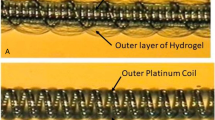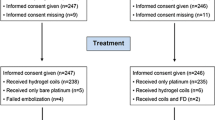Abstract
Purpose
Aneurysm recanalization constitutes a limitation in the endovascular treatment of intracranial aneurysms using conventional bare platinum coils. The development of platinum coils coupled with hydrogel polymers aimed at decreasing the rates of recurrence by way of enhanced coil packing density and biological healing within the aneurysm. While enhanced occlusion and durability has been shown for the first generation hydrogel coils, their use was limited by technical challenges. Less data is available regarding the second-generation hydrogel coils which have been designed to perform like bare platinum coils.
Methods
The new generation Hydrogel Endovascular Aneurysm Treatment Trial (HEAT) is a multicenter, randomized controlled trial that compares the health outcomes of the second-generation HydroCoil Embolic System with bare platinum coils in the endovascular intracranial aneurysms. The primary endpoint is aneurysm recurrence, defined as any progression on the Raymond aneurysm scale, over a 24-month follow-up period. Secondary endpoints include packing density, functional independence, procedural adverse events, mortality rate, initial complete occlusion, aneurysm retreatment, hemorrhage from treated aneurysm, and any aneurysm recurrence.
Results
Patient recruitment initiated in June 2011 and ended in January 2016 in 46 centers. Six hundred eligible patients diagnosed with an intracranial aneurysm, ruptured or unruptured were randomly assigned to one of the two treatment arms.
Conclusion
The HEAT trial compares the durability, imaging, and clinical outcomes of the second-generation hydrogel versus bare platinum coils in the endovascular treatment of ruptured or unruptured intracranial aneurysms. The results of this trial may further inform current endovascular treatment guidelines based on observed long-term outcomes.


Similar content being viewed by others
Abbreviations
- HEAT:
-
New generation Hydrogel Endovascular Aneurysm Treatment Trial
- BPC:
-
Bare platinum coil
- HC1:
-
First-generation HydroCoil
- IRB:
-
Institutional review board
- EDC:
-
Electronic data capture
- eCRF:
-
Procedure electronic case report form
- DSMB:
-
Data and Safety Monitoring Board
- ICF:
-
Informed consent form
References
Guglielmi G, Vinuela F, Duckwiler G et al (1992) Endovascular treatment of posterior circulation aneurysms by electrothrombosis using electrically detachable coils. J Neurosurg 77(4):515–524
Molyneux A, Kerr R, International Subarachnoid Aneurysm Trial Collaborative G et al (2002) International subarachnoid aneurysm trial (ISAT) of neurosurgical clipping versus endovascular coiling in 2143 patients with ruptured intracranial aneurysms: a randomized trial. J Stroke Cerebrovasc Dis 11(6):304–314
Byrne JV, Sohn MJ, Molyneux AJ, Chir B (1999) Five-year experience in using coil embolization for ruptured intracranial aneurysms: outcomes and incidence of late rebleeding. J Neurosurg 90(4):656–663
Molyneux AJ, Kerr RS, Birks J, Ramzi N, Yarnold J, Sneade M, Rischmiller J, ISAT Collaborators (2009) Risk of recurrent subarachnoid haemorrhage, death, or dependence and standardised mortality ratios after clipping or coiling of an intracranial aneurysm in the international subarachnoid aneurysm trial (ISAT): long-term follow-up. Lancet Neurol 8(5):427–433
Raymond J, Guilbert F, Weill A, Georganos SA, Juravsky L, Lambert A, Lamoureux J, Chagnon M, Roy D (2003) Long-term angiographic recurrences after selective endovascular treatment of aneurysms with detachable coils. Stroke 34(6):1398–1403
Chalouhi N, Bovenzi CD, Thakkar V, Dressler J, Jabbour P, Starke RM, Teufack S, Gonzalez LF, Dalyai R, Dumont AS, Rosenwasser R, Tjoumakaris S (2014) Long-term catheter angiography after aneurysm coil therapy: results of 209 patients and predictors of delayed recurrence and retreatment. J Neurosurg 121(5):1102–1106
Cognard C, Weill A, Castaings L, Rey A, Moret J (1998) Intracranial berry aneurysms: angiographic and clinical results after endovascular treatment. Radiology 206(2):499–510
White PM, Lewis SC, Nahser H, Sellar RJ, Goddard T, Gholkar A, on behalf of the HELPS Trial Collaboration (2008) HydroCoil endovascular aneurysm occlusion and packing study (HELPS trial): procedural safety and operator-assessed efficacy results. AJNR Am J Neuroradiol 29(2):217–223
Kallmes DF, Fujiwara NH (2002) New expandable hydrogel-platinum coil hybrid device for aneurysm embolization. AJNR Am J Neuroradiol 23(9):1580–1588
Yoshino Y, Niimi Y, Song JK, Silane M, Berenstein A (2004) Endovascular treatment of intracranial aneurysms: comparative evaluation in a terminal bifurcation aneurysm model in dogs. J Neurosurg 101(6):996–1003
Reinges MH, Krings T, Drexler AY et al (2010) Bare, bio-active and hydrogel-coated coils for endovascular treatment of experimentally induced aneurysms. Long-term histological and scanning electron microscopy results. Interv Neuroradiol 16(2):139–150
Zhang C, Chaudhary N, Gemmete JJ, Thompson BG, Xi G, Pandey AS (2014) Reactive tissue proliferation and damage of elastic lamina caused by hydrogel coated coils in experimental rat aneurysms. J Neurointerv Surg 6(6):480–486
Fanning NF, Berentei Z, Brennan PR, Thornton J (2007) HydroCoil as an adjuvant to bare platinum coil treatment of 100 cerebral aneurysms. Neuroradiology 49(2):139–148
Gaba RC, Ansari SA, Roy SS, Marden FA, Viana MA, Malisch TW (2006) Embolization of intracranial aneurysms with hydrogel-coated coils versus inert platinum coils: effects on packing density, coil length and quantity, procedure performance, cost, length of hospital stay, and durability of therapy. Stroke 37(6):1443–1450
Khan SH, Nichols C, Depowell JJ, Abruzzo TA, Ringer AJ (2012) Comparison of coil types in aneurysm recurrence. Clin Neurol Neurosurg 114(1):12–16
White PM, Lewis SC, Gholkar A, Sellar RJ, Nahser H, Cognard C, Forrester L, Wardlaw JM (2011) Hydrogel-coated coils versus bare platinum coils for the endovascular treatment of intracranial aneurysms (HELPS): a randomised controlled trial. Lancet 377(9778):1655–1662
Killer M, Kallmes D, Jones R, Ding Y, Vestal M, Hauser T, Virmani R, Cruise G (2010) Long-term angiographic and histological results of a new hydrogel-containing filling coil in experimental rabbit aneurysms. Minim Invasive Neurosurg 53(3):97–105
Tsumoto T, Niimi Y, Berenstein A (2009) Evaluation of the new HydroSoft coil in a canine model of bifurcation aneurysm. Laboratory investigation. J Neurosurg 111(1):11–16
Park JH, Kang HS, Han MH, Jeon P, Yoo DS, Lee TH, for the Korean HydroSoft Registry Investigators (2011) Embolization of intracranial aneurysms with HydroSoft coils: results of the Korean multicenter study. AJNR Am J Neuroradiol 32(9):1756–1761
Guo XB, Fan YM, Zhang JN (2011) HydroSoft coil versus HydroCoil for endovascular aneurysm occlusion study: a single center experience. Eur J Radiol 79(2):e42–e46
Meyers PM, Schumacher HC, Higashida RT, Derdeyn CP, Nesbit GM, Sacks D, Wechsler LR, Bederson JB, Lavine SD, Rasmussen P (2010) Reporting standards for endovascular repair of saccular intracranial cerebral aneurysms. AJNR Am J Neuroradiol 31(1):E12–E24
Author information
Authors and Affiliations
Corresponding author
Ethics declarations
Funding
The HEAT study was funded by MicroVention, Inc.
Conflict of interest
The authors declare that they have no conflict of interest.
Ethical approval
All procedures performed in the studies involving human participants were in accordance with the ethical standards of the institutional and/or national research committee and with the 1964 Helsinki Declaration and its later amendments or comparable ethical standards.
Informed consent
Informed consent was obtained from all individual participants included in the study.
Rights and permissions
About this article
Cite this article
Abi-Aad, K.R., Aoun, R.J.N., Rahme, R.J. et al. New generation Hydrogel Endovascular Aneurysm Treatment Trial (HEAT): a study protocol for a multicenter randomized controlled trial. Neuroradiology 60, 1075–1084 (2018). https://doi.org/10.1007/s00234-018-2074-5
Received:
Accepted:
Published:
Issue Date:
DOI: https://doi.org/10.1007/s00234-018-2074-5




